NASA is gearing up for its Europa Clipper mission, embarking on a remarkable 5½-year journey to explore Jupiter’s enigmatic moon, Europa, in the quest for environments that may support life.
Scientists are particularly intrigued by Europa due to its thick ice crust, measuring approximately 15 miles, which is believed to conceal a vast ocean that could be as deep as 80 miles. This hidden ocean may harbor organic compounds and harness energy from deep-sea thermal vents, creating conditions reminiscent of Earth’s oceans, where life first emerged.
While the Europa Clipper won’t search for life forms directly, it will utilize state-of-the-art instruments to map the moon’s surface, penetrate the ice with radar technology, and detect chemical signatures indicative of biological activity.
The spacecraft is equipped with enormous solar panels, each the size of a basketball court, and will conduct 49 flybys, coming as close as 16 miles to the surface of Europa.
The mission is set to culminate in 2034 with a controlled descent into Ganymede, another of Jupiter’s moons, which is also thought to potentially conceal an underground ocean. As the mission unfolds, scientists hope to uncover new insights into the possibility of life beyond Earth.’
Key Points
Mission Overview: NASA’s Europa Clipper mission is set for a 5½-year journey to explore Jupiter’s moon, Europa, to investigate conditions that may support life.
Reason for Selection: Europa is a prime target due to its thick ice crust (approximately 15 miles) believed to cover a deep ocean potentially reaching 80 miles.
Potential for Life: The hidden ocean might contain organic compounds and energy from deep-sea thermal vents, creating environments similar to Earth’s oceans.
Scientific Approach: The mission will not search for life forms directly but will utilize advanced instruments to map the surface, penetrate the ice using radar, and identify chemical signs of biological activity.
Power Source: The spacecraft is powered by large solar panels, each comparable in size to a basketball court.
Flybys: Europa Clipper will perform 49 flybys of Europa, with some coming as close as 16 miles to the surface.
Mission Conclusion: In 2034, the mission will conclude with a controlled descent into Ganymede, another of Jupiter’s moons, which may also harbor an underground ocean.
Scientific Goals: The mission aims to enhance understanding of the potential for life beyond Earth and to uncover new insights into the oceanic environments of icy moons.



